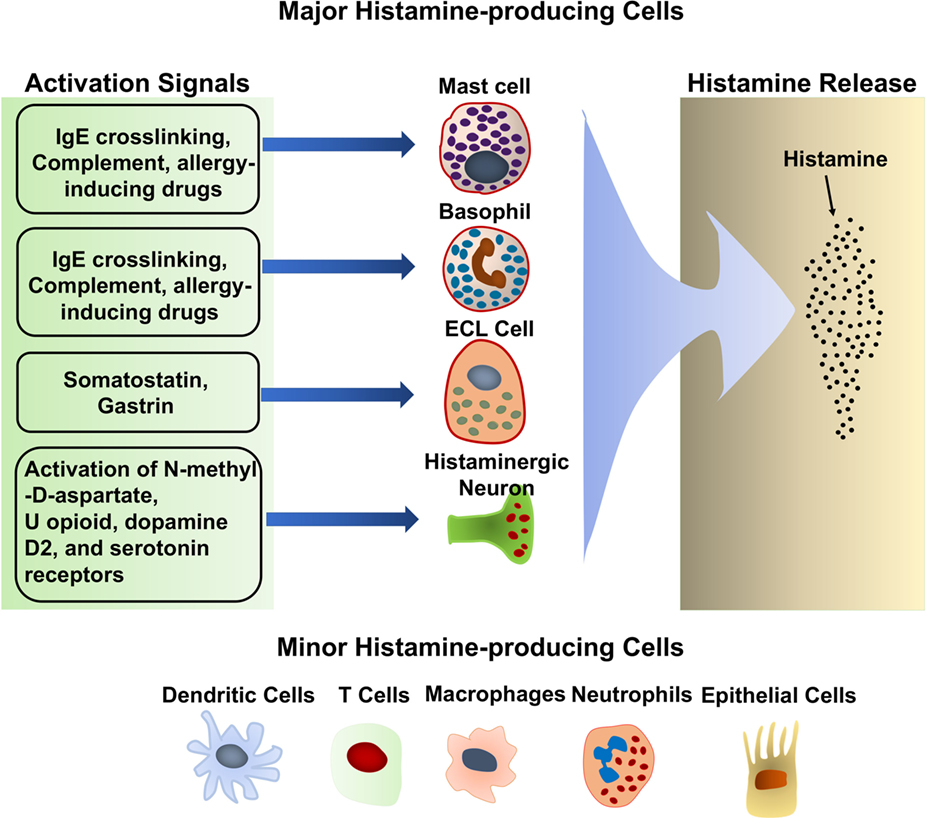Hi, my name is Allison Schaaf, my own fertility journey, including 5 miscarriages, inspired me to create this website to help YOU navigate your own fertility journey.
Here are my main takeaways I would share with you as a friend:
- Excess histamine may contribute to miscarriage, but is poorly understood and under-recognized.
- This article takes an in-depth look at how histamine works in the body.
- We also explore conditions that are often confused with histamine intolerance.
Of course, I also recommend you do your own research! That is why I have coordinated these articles with the nitty-gritty details and links to research so you can best decide what works best for you, read on for more! And don’t miss my Action Steps at the bottom of the article!
Table of Contents
What is histamine?
Histamine’s roles in women’s health, fertility, and pregnancy
Does histamine intolerance cause miscarriage?
Conditions that are easily confused with histamine intolerance
You may know that histamine relates to allergies, but it has many essential functions both in the body and in pregnancy. Elevated histamine levels and abnormal histamine processing, such as histamine intolerance, are often found in miscarriages and complicated pregnancies.
Keep in mind that scientists are still working to understand whether histamine problems are the cause or the effect of pregnancy complications1. Histamine levels can also rise once histamine-degrading enzymes drop in miscarriage or pre-eclampsia. The increase in histamine may explain miscarriage and postpartum hives and allergic symptoms, although these symptoms can occur during perfectly healthy pregnancies.
In order to understand how excess histamine affects health, you need to understand the roles of histamine in your body. That way, you can understand the symptoms of histamine intolerance and how histamines may contribute to miscarriage.
Diagnosing and addressing histamine disorders, especially in the context of recurrent miscarriage, requires more than just an antihistamine drug. This histamine series will cover everything you need to know about histamine and pregnancy based on the latest published research.
In this article, Part 1, we will cover what histamine is and what it does in your body related to fertility and pregnancy. Then, in the next article, Part 2, we will cover the definition, symptoms, causes, similar conditions, and potential treatments for histamine intolerance.
What is histamine?
Histamine is a biogenic amine produced from the amino acid histidine. It is a substance that your cells use to communicate with each other, such as to signal to your immune system. However, it also has numerous other important roles in the body.
Histamine production and breakdown

The enzyme histidine decarboxylase (HDC), which uses vitamin B6, produces histamine from the amino acid histidine inside mast cells. Other types of white blood cells, platelets, histaminergic neurons, and secretory cells in the gut also produce and release histamine 3.
These cells store histamine in small containers called vesicles, which can be emptied to outside the cells upon stimulation. Before the release, the enzyme histamine-N-methyltransferase (HNMT) can deactivate histamine4. Some people can have elevated histamine due to reduced HNMT function, although that is extremely rare.
Once something triggers the histamine-producing cells, they release histamine by emptying the vesicles into the space outside of the cells. Here, the enzyme diamine oxidase (DAO) is responsible for breaking down the released histamine 5.
DAO levels are highest in the gut, kidneys, and placenta, so any problems within these organs can affect histamine breakdown 6.
Other substances with the amine (ammonia group) group may also act like histamine in your body. We call these biogenic amines, with names that often end with -ine, such as spermidine, putrescine, and tyramine. DAO also breaks down these substances.
1) Allergy and inflammation mediator
Histamine is an important signal that your immune cells use to communicate with one another. During allergic symptoms, your mast cells release histamines, which attract other types of immune cells to the area.
In the airway, histamine release closes down the airway, while increasing the mucus production 7. In both airway allergies and injuries, histamine relaxes the blood vessels surrounding the area and increases blood flow, which leads to swelling or stuffy nose.
2) Gut movement and digestive function
Histamine protects the gut from pathogens by increasing stomach acid, stimulating bowel movement, and triggering nausea and vomiting. High histamines can often contribute to diarrhea-predominant irritable bowel syndrome 8. Excessive histamine, such as from eating spoiled fish with very high histamine, can cause diarrhea and vomiting.
Histamine also causes smooth muscle contraction thus sometimes provoking cramps, bloating, or abdominal distension 9.
3) Relaxes the blood vessel
Histamine increases blood flow to the injured or infected area while restricting the blood flow out of the area. It also makes the blood vessels more permeable, allowing liquid and other content from the blood to leak out 10. This can lead to local tissue swelling (edema). Excessively high histamine throughout the body, such as in anaphylactic shock, can lead to death due to blocked airway and rapid drop in blood pressure11.
An elevated level of histamine throughout the body can lower your blood pressure too much, causing postural orthostatic tachycardia syndrome (POTS). People with POTS may experience lightheadedness, dizziness, and racing heart beats if they get up too quickly.
4) Neurotransmitter
Histamine is an essential neurotransmitter in your brain. Histaminergic neurons use histamine to communicate with each other and among themselves. These neurons control unconscious processes such as circadian rhythm (body clock) or body temperature maintenance, and others more complex operations like learning and memory12.
Excessive brain histamine, however, can harm neurons and breach the blood-brain barrier, resulting in a leaky brain1314. Excess brain histamine may also cause neurological disorders, brain fog, and headaches 1516.
Histamine is an energizing and wakefulness neurotransmitter, which explains why antihistamines can make you sleepy. On the contrary, excess histamine can cause anxiety and insomnia 17.
In the hypothalamus, histamine controls hormone levels. It increases oxytocin, prolactin, adrenocorticotropic hormone while decreasing growth hormone and thyroid-stimulating hormone 18. Also, histamine suppresses appetite, while increasing thirst 19.
Histamine works as the main neurotransmitter that controls your brain’s nausea center, which explains why antihistamine drugs can help with motion sickness and morning sickness 2021.
5) Blood clotting
Histamine release into the blood stimulates blood clotting, which presumably helps close wounds2223 .
Histamine’s roles in women’s health, fertility, and pregnancy
Histamine is essential for sexual functions, fertility, and pregnancy in both genders. Proper histamine balance and function are critical for a healthy pregnancy because the embryonic and placental cells use histamine to communicate with each other. Not surprisingly, the placenta contains high levels of both HDC and DAO.
Preconception histamine
Histamine induces estrogen production from the ovaries, while estrogen induces histamine release from mast cells in the uterus 24. Whereas, progesterone inhibits histamine secretion 25. Your endometrial cells rely on histamine to communicate with each other as they prepare for implantation, so natural fluctuations of histamine during your cycle is normal.
However, excess histamine can increase estrogen, contributing to hormone imbalance. Histamine increases uterine contractions and also stimulates pain receptors 2627. Therefore, too much histamine contributes to increased estrogen, menstrual cramps, and cyclical headache and digestive problems 28. However, not all women who have these symptoms have histamine intolerance.
Many women with endometriosis have high histamine, abnormal histamine metabolism, and a tendency for allergic conditions 29. Therefore, histamine intolerance or mast cell activation disorder could contribute to endometriosis, although not all women with endometriosis have histamine intolerance.
Read our article on endometriosis.
Histamine during pregnancy
Because histamine is important for implantation, the use of antihistamines may inhibit implantation 30. After implantation, histamine increases HDC to produce histamine for use in developmental processes.
Total blood histamine is highest during the first trimester before declining during the second and third trimesters. The uterine lining, uterine muscles, and placenta are high in mast cells and HDC enzymes, which increase histamines in these tissues. Histamine also contributes to the secretion of many hormones, including human chorionic gonadotropin (HCG) from the placenta.
Histamine breakdown during pregnancy is also essential. The placenta produces the most DAO enzyme of any human tissues. Pregnancy DAO levels typically increase 500 – 1000 times during the first 20 weeks of pregnancy, thus reducing blood histamine levels 31. This may explain why some women can eat foods that they’re sensitive to during pregnancy.
Too much histamine or inability to keep histamine in the right compartments can lead to poor pregnancy outcomes. In pregnant mammals, injecting histamines caused uterine contractions, spontaneous miscarriage, and fetal malformations 32.
Elevated histamine and inability to increase placental DAO is associated with:
- Pre-eclampsia (dangerously high blood pressure during pregnancy), with total blood histamine correlating with its severity 33
- Hyperemesis gravidarum (extreme morning sickness)34
- Increased risk of spontaneous and threatened miscarriage 3536
- Intrauterine growth retardation 37
- Preterm labor38
These pregnancy complications could be due to blood clots, abnormal blood vessel function, abnormal placenta development, or uterine contractions 3940.
Does histamine intolerance cause miscarriage?
Histamine intolerance is not an intolerance to histamine in your body. Rather, it is mainly a food intolerance resulting from increased histamine burden and reduced ability to breakdown histamine. People with histamine intolerance often develop symptoms due to excessive histamine after consuming foods high in biogenic amines or histamine liberators, which stimulate histamine release.
No study has conclusively confirmed that histamine intolerance causes miscarriage, although it makes sense that excess histamine and inflammation can disrupt a pregnancy. Also, there are many other reasons histamine could be elevated (See Conditions that are easily confused with histamine intolerance below).
Low maternal DAO levels are associated with a 16.6 times increased risk of miscarriage at 12 weeks 41. However, we still don’t know if the low DAO caused the miscarriages or if the miscarriage reduced the DAO.
Plausibly, the elevated histamine throws off the estrogen and prostaglandin balances, which may contribute to the miscarriage. The reduced DAO may also explain the allergic symptoms some women experience right before a miscarriage.
Histamine intolerance is not the only disorder that may cause miscarriage by elevating histamine. If you have excess histamine symptoms and miscarriage, be sure to work with a doctor to get the correct diagnosis.
Conditions that are easily confused with histamine intolerance
Anything that elevates histamine levels can be easily confused with histamine intolerance. These conditions can also cause miscarriage. Note that it is possible to have both histamine intolerance and the following conditions.
True allergy
Histamine intolerance symptoms are very similar to allergic symptoms. If you have symptoms of histamine intolerance and suspect you may have it, see an allergist to get tested for true allergies. Then, avoid those allergens or remove them as much as possible. If your symptoms subside, it is more likely just allergies rather than DAO.
Food allergies, which can be detected with specific IgE blood tests for each food item, can also cause any of the symptoms of histamine intolerance. Your doctor may recommend eliminating these foods and bringing them back to confirm the results.
Scombroid fish poisoning 42
Scombroid fish poisoning is a type of histamine overdose from eating spoiled fish. Symptoms resemble an acute allergic reaction and commonly appear 10–60 minutes after eating contaminated fish. The most common manifestations consist of skin flushing on the upper half of the body, rash, gastrointestinal complaints, and headache. Usually, the diagnosis is based on history, although histamine levels can be measured in the uneaten portions of the fish.
Mast Cell Activation Syndrome (MCAS) or Mastocytosis 43
Mast cell activation syndrome (MCAS) or mastocytosis is a condition where mast cells are overactive and release more inflammatory mediators than normal, with or without provocation. These patients may also have more mast cells than normal. Histamine is one such mediator, but there are several others, such as prostaglandins and leukotrienes. MCAS symptoms are very similar to histamine intolerance, including miscarriage and other pregnancy complications. MCAS patients may have a few key symptoms that are not typical in histamine intolerance 44:
- 76% of people with MCAS have skin dermatographia, developing red marks lasting over 30 minutes after a light scratch on their skin
- Abnormal blood clotting or bleeding/bruising without other identifiable causes
- Strange food and medication reactions
- Symptoms may be severe and spontaneous, without provocation
The American Academy of Allergy, Asthma & Immunology recommends the following blood tests to diagnose MCAS45:
- Serum mast cells tryptase, which is a marker of excessive mast cell activation46
- Normal <10 ng/mL
- Slightly elevated 10 – 50 ng/mL
- Massively elevated >50 ng/mL
- Skin and bone marrow biopsies for increased mast cells.
The following blood tests may also be considered, although they are less specific to mast cell disorders and thus less reliable 47:
- N-methylhistamine
- 11B-prostaglandin F2alpha
- leukotriene E4
Managing MCAS involves identifying and removing all potential triggers, including substances, physical, and psychological triggers. Then, the right combination of antihistamines and mast cell blockers for each patient can help control the symptoms 48.
Conclusion
If you have had a miscarriage and suspect excess histamine, work with the appropriate physician to get diagnosed and treated.
In Part 2 of this 2-part series, we will cover more in detail about histamine intolerance, including causes, symptoms, and treatments.
Next Steps to Consider
- Check out Part 2 of our series on histamine intolerance to learn more about causes, symptoms and contributing factors.
References




0 Comments